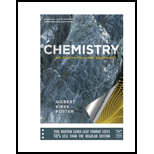
To find:
a) State whether the rate law is consistent with the observed order of the reaction for
b) Find the value activation energy of the reaction.
c) Find the rate of the reaction at
d) Find the values of the rate constant at
Answer to Problem 13.135QA
Solution:
a) Yes, if the given reaction occur in a single step the rate law would be consistent with the observed order of the reaction for
b) The value activation energy of the reaction is
c) The rate of the reaction at
d) The value of the rate constant at
Explanation of Solution
1) Concept:
From the given reaction, we will check, how the
We have to use the formula for calculating activation energy.
2) Given:
We have given the reaction
This reaction is first order with respect to
| Temperature |
Temperature |
Rate constant |
At
3) Formula:
Where,
4) Calculations:
a) The given reaction is,
Here one molecule of
Therefore, if the given reaction occurs in a single step, the rate law would be consistent with the observed order of the reaction for
b) To calculate activation energy, we have formula,
So, by putting the values,
Therefore, the value of activation energy of the reaction is
c) This reaction is first order with respect to
At
Therefore, at
d) The values of the rate constant at
e)
i. Rate constant at
We are using the formula of activation energy. By putting value of rate constant at
ii. Rate constant at
We are using the formula of activation energy. By putting value of rate constant at
At
Conclusion:
a) Yes, if the given reaction occurs in a single step the rate law would be consistent with the observed order of the reaction for
b) The value activation energy of the reaction is
c) The rate of the reaction at
d) The value of the rate constant at
e)
Want to see more full solutions like this?
Chapter 13 Solutions
Chemistry: An Atoms-Focused Approach
 ChemistryChemistryISBN:9781305957404Author:Steven S. Zumdahl, Susan A. Zumdahl, Donald J. DeCostePublisher:Cengage Learning
ChemistryChemistryISBN:9781305957404Author:Steven S. Zumdahl, Susan A. Zumdahl, Donald J. DeCostePublisher:Cengage Learning ChemistryChemistryISBN:9781259911156Author:Raymond Chang Dr., Jason Overby ProfessorPublisher:McGraw-Hill Education
ChemistryChemistryISBN:9781259911156Author:Raymond Chang Dr., Jason Overby ProfessorPublisher:McGraw-Hill Education Principles of Instrumental AnalysisChemistryISBN:9781305577213Author:Douglas A. Skoog, F. James Holler, Stanley R. CrouchPublisher:Cengage Learning
Principles of Instrumental AnalysisChemistryISBN:9781305577213Author:Douglas A. Skoog, F. James Holler, Stanley R. CrouchPublisher:Cengage Learning Organic ChemistryChemistryISBN:9780078021558Author:Janice Gorzynski Smith Dr.Publisher:McGraw-Hill Education
Organic ChemistryChemistryISBN:9780078021558Author:Janice Gorzynski Smith Dr.Publisher:McGraw-Hill Education Chemistry: Principles and ReactionsChemistryISBN:9781305079373Author:William L. Masterton, Cecile N. HurleyPublisher:Cengage Learning
Chemistry: Principles and ReactionsChemistryISBN:9781305079373Author:William L. Masterton, Cecile N. HurleyPublisher:Cengage Learning Elementary Principles of Chemical Processes, Bind...ChemistryISBN:9781118431221Author:Richard M. Felder, Ronald W. Rousseau, Lisa G. BullardPublisher:WILEY
Elementary Principles of Chemical Processes, Bind...ChemistryISBN:9781118431221Author:Richard M. Felder, Ronald W. Rousseau, Lisa G. BullardPublisher:WILEY





